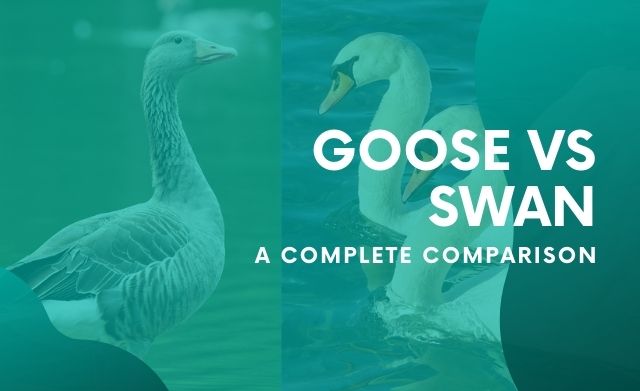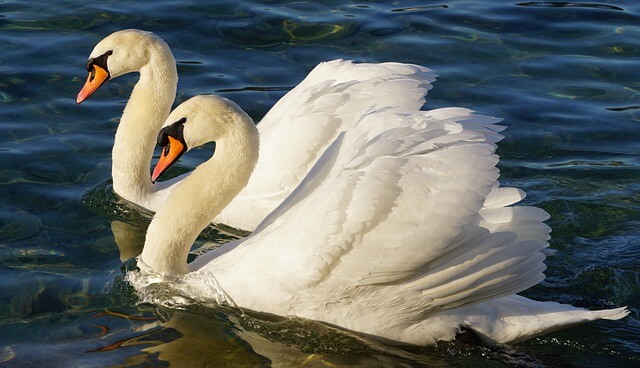
Some people confuse several waterfowls, having that in mind, this article will try to clarify the difference between goose and swan.
Waterbirds are seen around us, on the lakes, ponds, or flying up in a flock. It is natural to use the term swan instead of a goose as these birds have many significant factors in common.
Literally, The waterfowl species from Anser and Branta genera from the Anserini tribe are geese, ganders, and goslings. On the other hand, Swans are any species of birds from the Cygnus genus from the Cygnini biological tribe.
Anserine and Cygnini tribes belong to the Anserinae subfamily, which belongs to the Anatidae family from the Anseriformes order of Aves class of chordate animals (Aves biological class consists of all the birds). Anatidae’s biological family comprises goose, swan, and duck-like waterfowls. Some birds of this family are whistling ducks, dabbling ducks, freckled ducks, shelducks/sheldgeese, pygmy geese, swans, pochards, etc.
Table of Contents
Comparison chart
| Difference | Goose | Swan |
| Taxonomy | Geese are from Anser and Branta genera. | Swans are from the Cygnus genus from the Cygnini biological tribe. |
| Domestic species or subspecies | There are two domestic subspecies of goose. | There are no domestic species or subspecies of the coscoroba swan. |
| Distribution and habitat | Goose can found all over the world. | Swan can be found in temperate regions, generally not in the tropical region. |
| Gender identification | Goose genders are less identical than the swan. | Swan genders are more identical than the goose. |
| Bare skin between the eyes and bill | Goose does not have bare skin between eyes and bill. | Swan has a patch of featherless skin between eyes and bill. |
| Linear body shape | Geese have a smaller body shape than swans. | Swans are bigger than geese in linear body shape. |
| Wingspan | Geese have a shorter wingspan than swans. | Swans have a broader wingspan than geese. |
| Weight | Geese are lighter than swans. | Swans are heavier than geese. |
| Head | Geese have a smaller head than swans. | Swans have a bigger head than geese. |
| Neck | Geese have a smaller neck than swans. | Swans have larger and more curved necks than geese. |
| Legs | Geese have shorter legs than swans. | Swans have longer legs than geese. |
| Behavior | In a usual time, the female goose is less offensive, less suspicious than the male goose. But they become more aggressive than the male during pregnancy. | Pens are more offensive, more suspicious than male swans. |
| Appearance | Female geese get body and neck position horizontally. It is a posture of submission to the male. Ganders tend to raise their head high, point their bills up, and stretch their body into a vertical position. It is a show up about their dominance on the female. | The pen tends to be larger in appearance than the cob. |
Goose
The term Goose indicates any of several large waterfowl birds from the Anatidae family. The waterfowl group comprises two genera Anser and Branta. In the English language, the word goose (plural geese) commonly used for a female bird, whereas gander for a male bird (read our article on goose vs. gander) and gosling (plural goslings) for a baby one that cannot fly.

When on the land, a geese group is called a gaggle, a group of geese in flight is called a wedge/skein/team, and a wedge/skein/team flying in a flock are called a plump.
The genus Anser comprises the gray geese and the white geese, and the genus Branta consists of the black geese. Some waterfowls like Cape Barren goose, New Zealand goose, Pygmy goose, Spur-winged goose, Sheldgoose from Anatidae biological family are not true geese. On the other hand, the coscoroba swan has some similar features to both goose and swan.
Generally, geese are larger in size than ducks and smaller than swans. They are web-footed and have long necks.
Goose species
There are several existing wild and domestic species of geese, such as
- Bar-headed goose
- Emperor goose
- Ross’s goose
- Snow goose
- Greylag goose
- Swan goose
- Pink-footed goose
- Tundra bean goose, etc.
As per fossil records, there are twenty-three extinct types of geese to date. However, not all of them are true geese. Some of these extinct birds are the Orinoco goose, the Egyptian goose, the South American sheldgeese, the prehistoric Malagasy sheldgoose, the blue-winged geese, the Cape Barren goose, the pygmy goose, etc.
SWAN
The waterfowl species from Cygnus genus from Cygnini tribe are true swans. Swans are the largest waterfowl in the Anatidae biological family. They are also one of the largest flying birds.

Swans are generally larger than geese in body length, wingspans, and weight. They have slender necks, a patch of bare skin between eyes and bill. The legs of swans are shorter compared to the legs of geese. The male swans are called Cobs, while the females are known as Pens. A baby swan that cannot fly is called Cygnet or Swanling. A group of swans on the ground is called a Herd, and the flying swans’ flock is known as a Bevy or a Wedge.
Swan species
As per fossil records, there are six existing and thirteen extinct species of swans. Existing swan species are
- Black-necked swan
- Mute swan
- Black swan
- Trumpeter swan
- Whooper swan
- Tundra swan
There are two subspecies of Tundra swans, Whistling swan and Bewick’s swan.
The key differences between Goose and Swan
- Geese are from Anser and Branta genera. Swans are from the Cygnus genus.
- Swans are heavier and bigger in linear body shape and have a broader wingspan than geese. Swans have a larger and more curved neck, a larger head, and longer legs compared to geese.
- Swans have a patch of bare skin between their eyes and bill. Goose does not have such patches of bare skin in this body-region.
- Goose has two domestic subspecies. There are no domestic species or subspecies of the swan.
- Geese are brown, blackish, grey birds with white areas on the tail and chest. On the other hand, swans are mostly white(sometimes with black spots) or completely black(rare) birds.
Goose vs swan: population
The population size of the swans is pretty less when compared to the population size of the geese. There are more than 5 million Canadian geese, 2 million Ross’s geese, 15 million snow geese, around 9 million Bean geese, and so on.
On the other hand, the total population size of swans under seven different species is around 1.5-1.6 million worldwide. According to a Cambridge study in South Korea, Japan, and China, there are approximately 6,00000 geese under four species, and 2,00000 swans under two species could be estimated.
Frequently asked questions (FAQs):
Is swan goose a goose or a swan?
The swan goose (Anser cygnoides) is a goose, not a swan.
Can anybody own a swan in the United States?
Yes. But as an invasive species, only the mute swans (Cygnus olor) have restrictions in the states of California, Maryland, New York, and Oregon.
Are Cape Barren goose, New Zealand goose, pygmy goose, sheldgoose, spur-winged goose true geese?
No. Sheldgoose or shelduck, Cape Barren goose, New-Zealand goose, pygmy goose, spur-winged goose are not true geese.
Is coscoroba swan a swan or a goose?
No. Coscoroba swan is not a true swan. It has some common features of both goose and swan. It has a few more similarities with goose than swan.
Can swans and geese mate? What is a swoose?
Swans and geese mate often. But they have no natural breeding. A swoose is the captive breeding of swan and goose.
Is there any goose and swan hybrid?
Goose and swan have no natural breeding. Swooses are the captive breeding swans and goose.
What is snow goose?
The snow goose (Anser caerulescens) is a goose species from Anser genus (white and gray goose) native to North America.
What is the Flying geese paradigm?
The Flying geese paradigm (FGP) is a Japanese theory of technological progress of the south-east Asian countries viewing Japan as a leader.
What is the Black swan theory?
The Theory of black swan or the Black swan theory is a metaphor, which describes a hard-to-predict event that comes as a surprise and has a major effect on history, finance, science, and technology.
Conclusion
The difference between goose and swan is in their genus, physical features, and other characteristics. As both these water birds evolved from ducks millions of years ago, it’s natural to share some significant features between them. Hence, this article tried to describe some individual features of goose and swan in order to clarify the confusion.

Monroe is a science enthusiast, a molecular biology graduate, and a zoophilist. He’s been writing articles on general science for nearly a decade and helping local school kids on various scientific projects.
